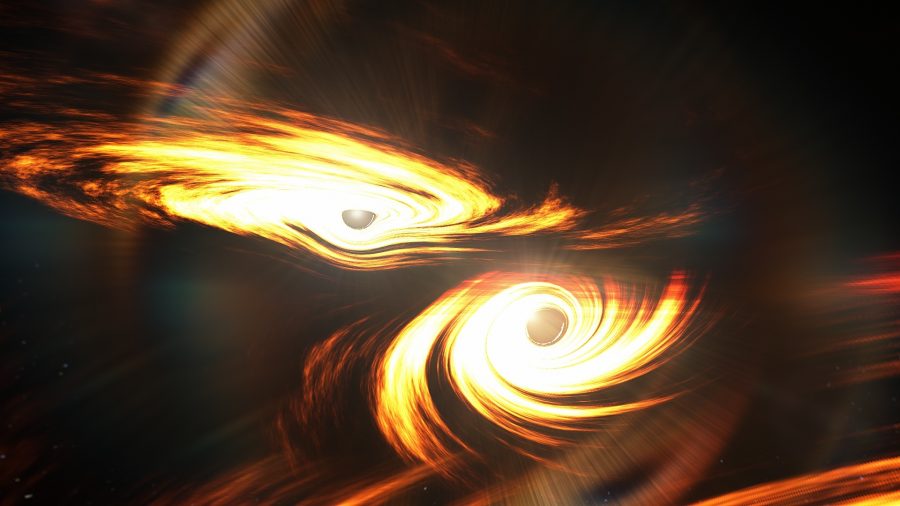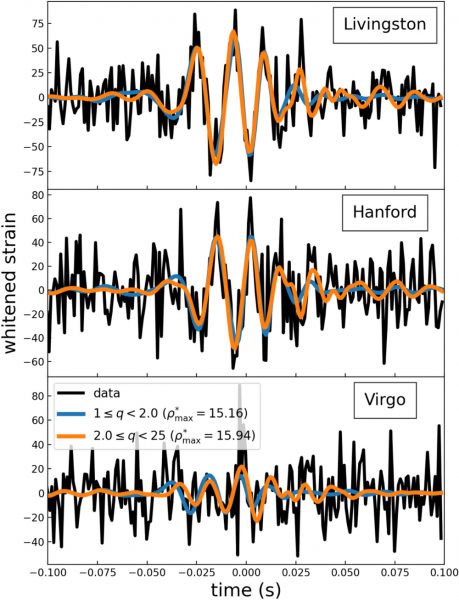Could the biggest — literally — gravitational-wave discovery yet be something other than what it initially seemed?

LIGO / Caltech / MIT / R. Hurt (IPAC)
A new study suggests that the most massive merger of black holes detected by LIGO/Virgo may have included a surprising lightweight.
Echoes of a Surprising Merger
In May 2019, a collision of two black holes shook spacetime, registering in the LIGO and Virgo gravitational-wave detectors as the heaviest black-hole merger discovered yet. Initial analysis of GW190521 suggested that the participants in this cosmic collision were ~85 and ~66 times the mass of the Sun, and that they formed a final black hole of ~142 solar masses — an unexpectedly heavy outcome that lands in the elusive category of intermediate-mass black holes.

LIGO-Virgo / Northwestern U. / Frank Elavsky & Aaron Geller
But GW190521 raised eyebrows for another reason as well: the estimated masses of the two merging black holes fell between 65 and 120 solar masses, a region known as the pair-instability mass gap. This range of masses should be inherently off-limits for black holes born from collapsed stars, based on our current understanding of stellar evolution processes.
While there are many hypotheses about how mass-gap black holes could potentially form, two scientists have focused on an alternative angle: what if we were simply wrong in our estimate of GW190521’s component masses?
Checking Our Assumptions
How do we measure component masses from a gravitational-wave signal? Decades of theoretical research have produced a vast array of model signals for mergers with different parameters. By comparing the observed gravitational-wave signal to the various models, we can calculate which ones fit best. But this comparison relies on what are called priors — a set of assumptions that go into the analysis and affect the outcome.

Nitz & Capano 2021
In a recent publication, scientists Alexander Nitz and Collin Capano (Max Planck Institute for Gravitational Physics and Leibniz University Hannover, Germany) reanalyze the gravitational-wave signal for GW190521 using a different set of priors and constraints than the original analysis completed by the LIGO collaboration.
Nitz and Capano find that their analysis admits two possible solutions for GW190521: one similar to that found by the LIGO collaboration — and another, in which the component black holes are ~16 and ~170 solar masses. This second option becomes even more heavily favored when the authors analyze the gravitational-wave signal simultaneously with an electromagnetic flare that may have been associated with the merger.
An Uneven Pair?
What does this outcome tell us? The masses in Nitz and Capano’s second solution both lie outside of the pair-instability mass gap, neatly resolving the paradox previously created by this merger.
If the authors’ interpretation is correct, then GW190521 would represent the first detected intermediate-mass-ratio inspiral — a type of merger in which one component is substantially larger than the other. This signal then provides an exciting milestone and an opportunity to learn more about the different types of dramatic collisions that occur in our galaxy.
Citation
“GW190521 May Be an Intermediate-mass Ratio Inspiral,” Alexander H. Nitz and Collin D. Capano 2021 ApJL 907 L9. doi:10.3847/2041-8213/abccc5
This post originally appeared on AAS Nova, which features research highlights from the journals of the American Astronomical Society.
 2
2









Comments
Peter Wilson
April 24, 2021 at 10:13 am
The data looks pretty fuzzy. It's astounding they get out of it what they do.
You must be logged in to post a comment.
Yaron Sheffer
April 26, 2021 at 11:23 am
Au contraire. The fuzzier the data, the easier it is to get whatever you wish out of it :^)
You must be logged in to post a comment.
You must be logged in to post a comment.